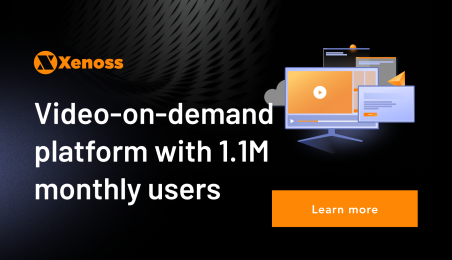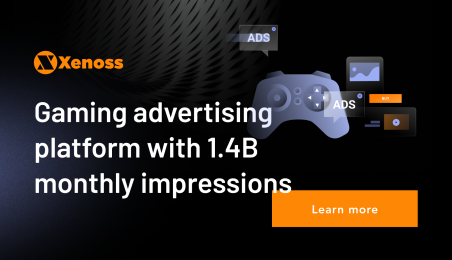In-game advertising is a scorching hot niche. According to a 2021 IronSource survey, 32% of advertisers plan to increase in-game budgets and 49% want to add this option to their marketing mix.
Unlike other channels, in-game advertising is less prone to ad blocking and delivers higher viewability because ads are contextually backed into the gameplay. So? Media buyers are hooked. But what about AdTech platforms? Are they well-positioned to tap into this growing channel?
If you too are wondering what it would take to launch in-game advertising functionality for mobile, web, and console games, this primer is for you.
In this post, we cover the common product development challenges – around scalability, ad viewability, and personalization, among others – with tech approaches for resolving these.
The main perils of implementing in-game advertising functionality
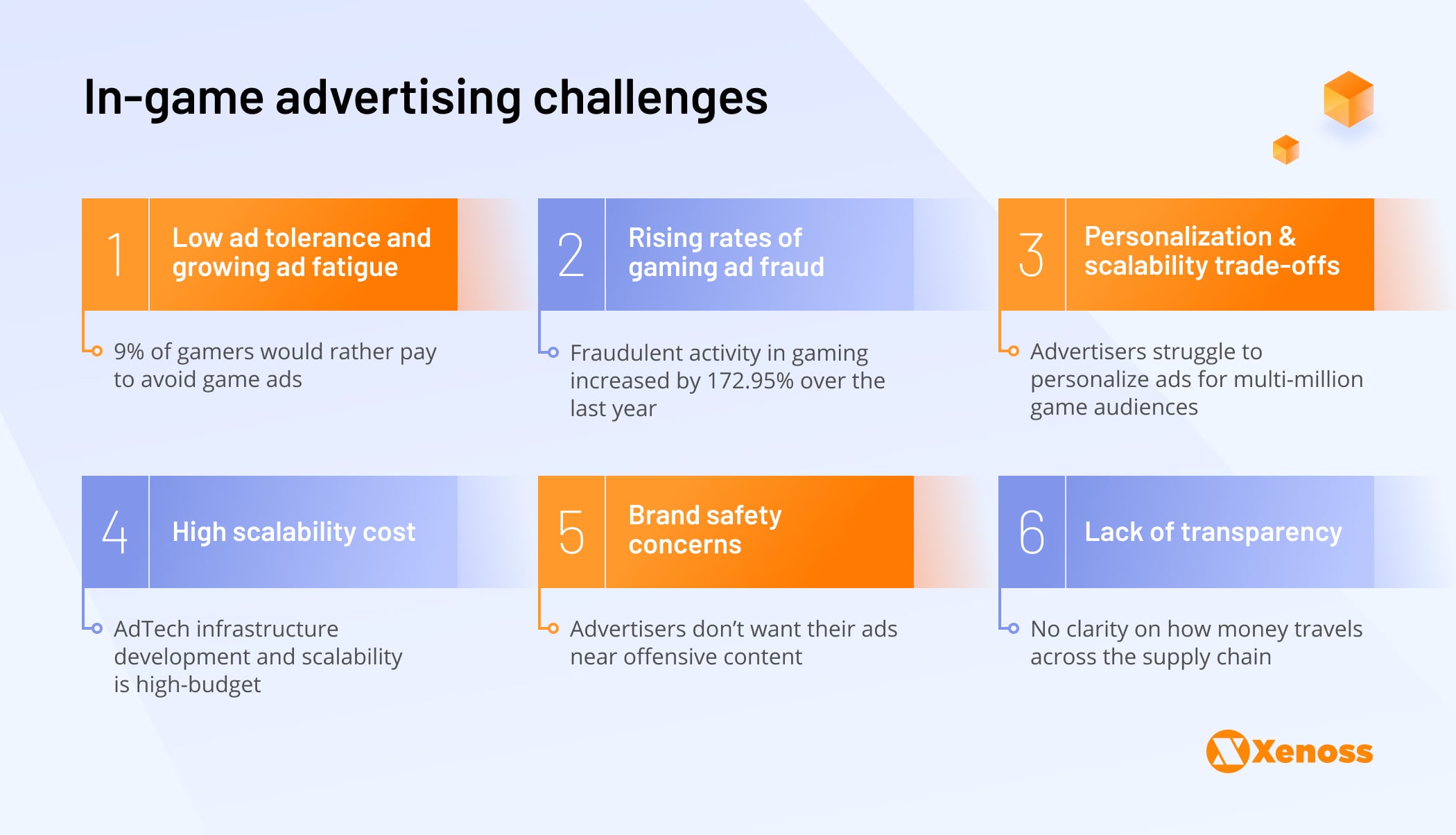
The standard technical qualities – scalability, high performance, and real-time data processing – are a must for any type of AdTech solution. But serving dynamic in-game advertising adds extra technical intricacies.
Here are six challenges AdTech product owners have to account for.
1. Growing ad fatigue and low ad tolerance among gamers
Roughly 94% of free-to-play games monetize through ads. That’s great – you have a large inventory to tap into.
But there are two problems with this:
- Gamers, especially on mobile, are tired of the same (annoying) ad formats.
- Publishers, fueled by the growing demand, offer sub-par ad placements.
That’s why brand metrics like Cost-Per-Conversion (CPC) rise, while ROAS (Return on Ad Spend) plummets.
In fact, per Deloitte 2021 Millennial Survey:
49% of gamers would rather pay to avoid game ads. Also, gaming services subscribers are most likely to cancel their subscription if the service adds advertising or increases the number of ads.
…While many more simply turn over their phone, get a more sophisticated ad blocker, or develop progressive blindness towards advertising on gaming apps.
The above sentiment puts AdTechs in a tough position: You need to balance the amount, quality, and relevance of served ads (to keep users happy) while delivering high engagement rates to retain brands.
One way to solve this issue is to create more engaging and contextual ad formats for games such as:
- Virtual billboards
- In-world product placements
- Personalized interstitials and pop-ups
- Contextual reward ads
- Branded in-game products
Gamers respond better to such blended advertising experiences. IAB UK recently analyzed how gamers engaged with different Red Bull advertising formats. Forty-two percent had a preference for ads seamlessly integrated into the gameplay experience. By comparison, only 30% favored banner ads on news websites.
The takeaway: Dynamic in-game advertising should be contextually relevant and effectively placed, especially if you’re looking to attract big-name game publishers and brands alike.
2. Rising rates of gaming ad fraud
Mobile ad fraud levels are staggering. Gaming apps are part of the problem too. Globally, fraudulent activity in gaming increased by 172.95% over the last year and by a whopping 310% in the US alone.
The common types of mobile ad fraud impacting in-game advertising include:
- Click injection
- Bot farming
- SDK spoofing
- Click spam
- Cost-per-install fraud
For AdTechs, fraud translates to compromised analytics. That’s when the impression numbers become too good to be true while conversions stay flat. Advertisers begin to wonder why they are spending money with you.
At the same time, vetting every game publisher individually – across metrics such as ad verification, brand safety, and attention – is unfeasible.
Therefore, you should consider how you will filter traffic and verify conversions for in-game ads both for advertisers’ and regulators’ sake.
Because authorities are in alert mode too, the Media Rating Council, together with IAB, now urges all advertisers to detect and exclude the following types of invalid traffic:
- Data center traffic – the most common type of general invalid traffic (GIVT) in gaming
- Bots, spiders, web crawlers, and other types of automated services
- Non-browser user-agent headers or other forms of unknown browsers
- Excessive activity – sessions that generate suspiciously high ad volumes must be flagged
While statistically GIVT volumes are lower for in-game advertising, you must still ensure that proper measurement and validation mechanisms are in place.
3. Delivering ad personalization at scale
As we mentioned earlier, contextual placements strike a chord with gamers.
But serving immersive ads – ones that naturally fit the game – isn’t enough to ensure high conversions. You also need personalization.
Think about it: Gamers already have the ability to customize nearly every aspect of their characters and gameplay. Sims 4 and Minecraft are two examples of games with millions of user-generated custom content packs and creators, specializing in their development.
When users spend a significant amount of time creating their own fantasy world, they are utterly disappointed when bombarded with generic ads.
Technologically we are already at a stage where an AdTech platform can deliver ultra-relevant ads using:
- Cross-channel integrations
- Intelligent data processing
- Custom machine learning algorithms
With these technologies in place, your AdTech platform can help advertisers generate personalized ads based on the users’ demographics, interests, location, or even past in-game actions.
According to McKinsey:
Advanced personalization drives incredible ROI for brands – 5-15% lift in revenue and 10-30% increases in marketing-spend efficiency.
What’s more, in-game advertising may soon become the last bastion of personalization. As Google plans to ban third-party data collection via cookies by 2023, many advertisers will shift to alternative channels.
Your AdTech software can meet their needs if you figure out the right approach to in-game advertising personalization.
4. Costly platform scalability
As in-game advertising grows, AdTech platforms must improve the speed at which they serve dynamic ads across a wide inventory. Moreover, you’ll need to add new ad networks and individual game publishers to your books.
But such growth comes at a technical cost. Suboptimal IT infrastructure configuration can leave AdTechs with an ever-growing bill – one that new revenue gains may not offset.
Yes, AdTech’s IT infrastructure is complex. But failure to come up with proper architecture design will lead to horrendous overspending without any gains in performance or availability.
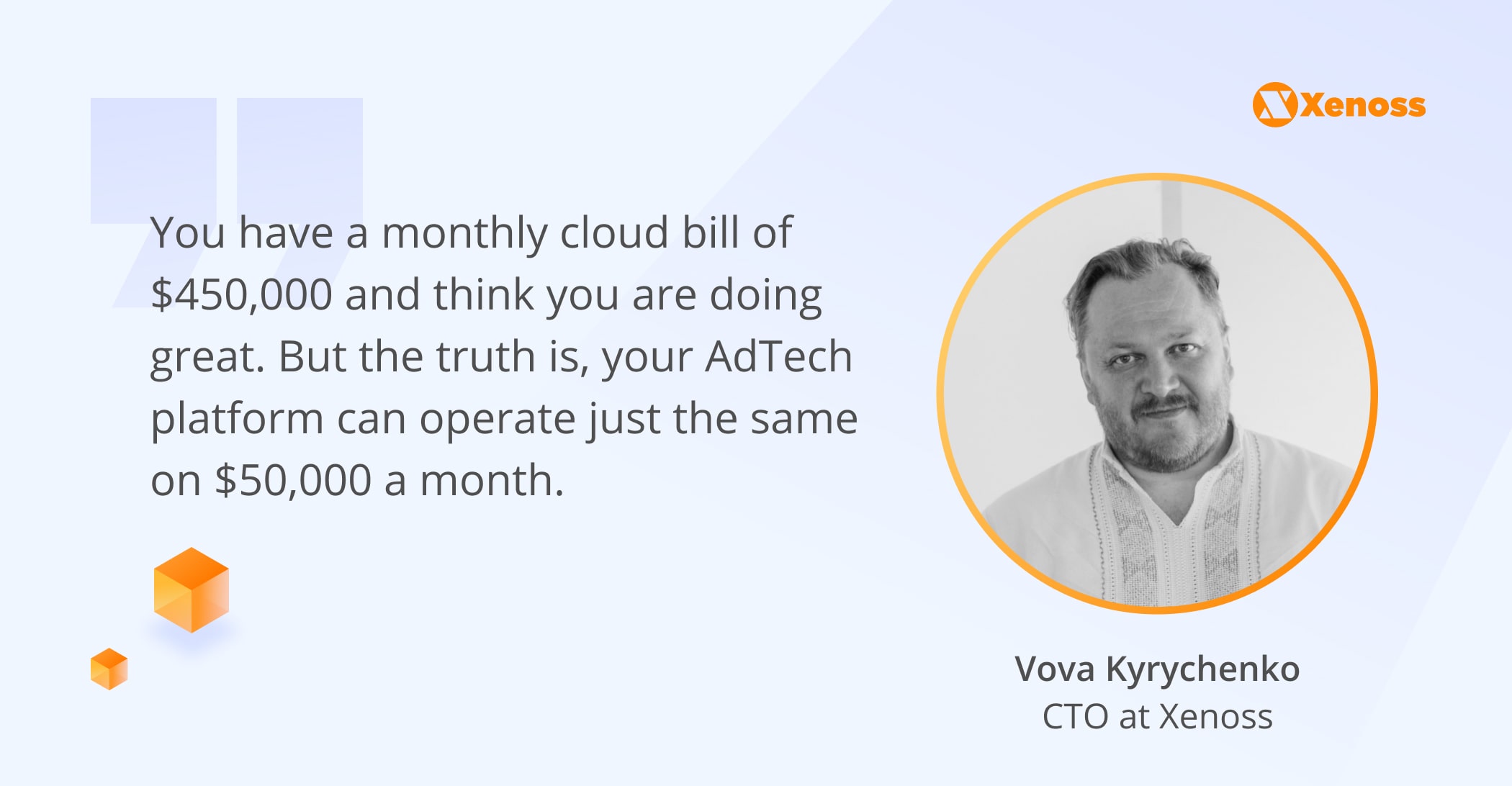
Take it from Twitter, when the company decided to modernize its ad platform, the effort was initially stalled by:
- Large, bloated data structures
- Data access challenges
- Technical debt
Due to these issues, Twitter decided to break down the legacy monolith platform into several loosely coupled sub-services and reorganize these horizontally as microservices, connected by APIs.
The team also admitted that this decision required ruthless cost control:
“Creating many different services from a single service certainly meant increased compute cost to run those systems. In order to make sure that the increase is within an acceptable limit, we set ourselves a concrete goal of keeping the cost to operate the ads serving systems to be within 5% of the revenue we make from it. This helped us prioritize efficiency where needed, and make design decisions easy.”
When it comes to AdTech platform development you have to set clear cost ballparks on how much you can afford to spend on maintaining your infrastructure. Suboptimal architectural decisions and technical debt = cosmic operational bills.
5. Concerns around brand safety
Due to negative media coverage, video games have acquired a somewhat unsavory reputation. In-game advertisements are viewed as unsafe by some brands.
But nothing can be any further from the truth. Studies show that mobile games are better for brand safety than social media:
The majority of respondents (60%) said they see offensive content on Facebook, compared to 31% on YouTube, and 18% on mobile games.
Sadly, AdTech platforms now need to beat that brand safety stigma among both advertisers and regulators.
Detailed reports on General Invalid Traffic (GIVT) and Sophisticated Invalid Traffic (SIVT) are the first steps towards greater reassurance. But many brands want more than that. For example, guarantees that their advertising will never appear:
- Next to offensive content or competitors
- In unsafe game environments (e.g., promoting violence)
- As forced, disruptive, or annoying pop-ups
To deliver on these demands for mobile game advertising, AdTech platforms will have to address a flurry of issues:
- Develop brand safety settings for programmatic buys
- Implement proper fourth-party ad verification tags for identifying violations
- Add identification mechanisms for selection and prioritization of vetted sellers in the ecosystem
- Create pre-bid filters and post-bid blocking protocols to prevent accidental purchases
- Maintain an active blacklist of dubious publishers
That sounds like a big list. But these issues can be addressed through one effective tech solution we discuss in the next subsection ;).
6. Lack of transparency in ad supply chains
Video game ads have some bad rep, but so do programmatic AdTech platforms.
The reason being: No one knows how money travels across the ad supply chains.
The programmatic ad buying ecosystem has become so complex that publishers now receive only 51% of what an advertiser has spent on average.
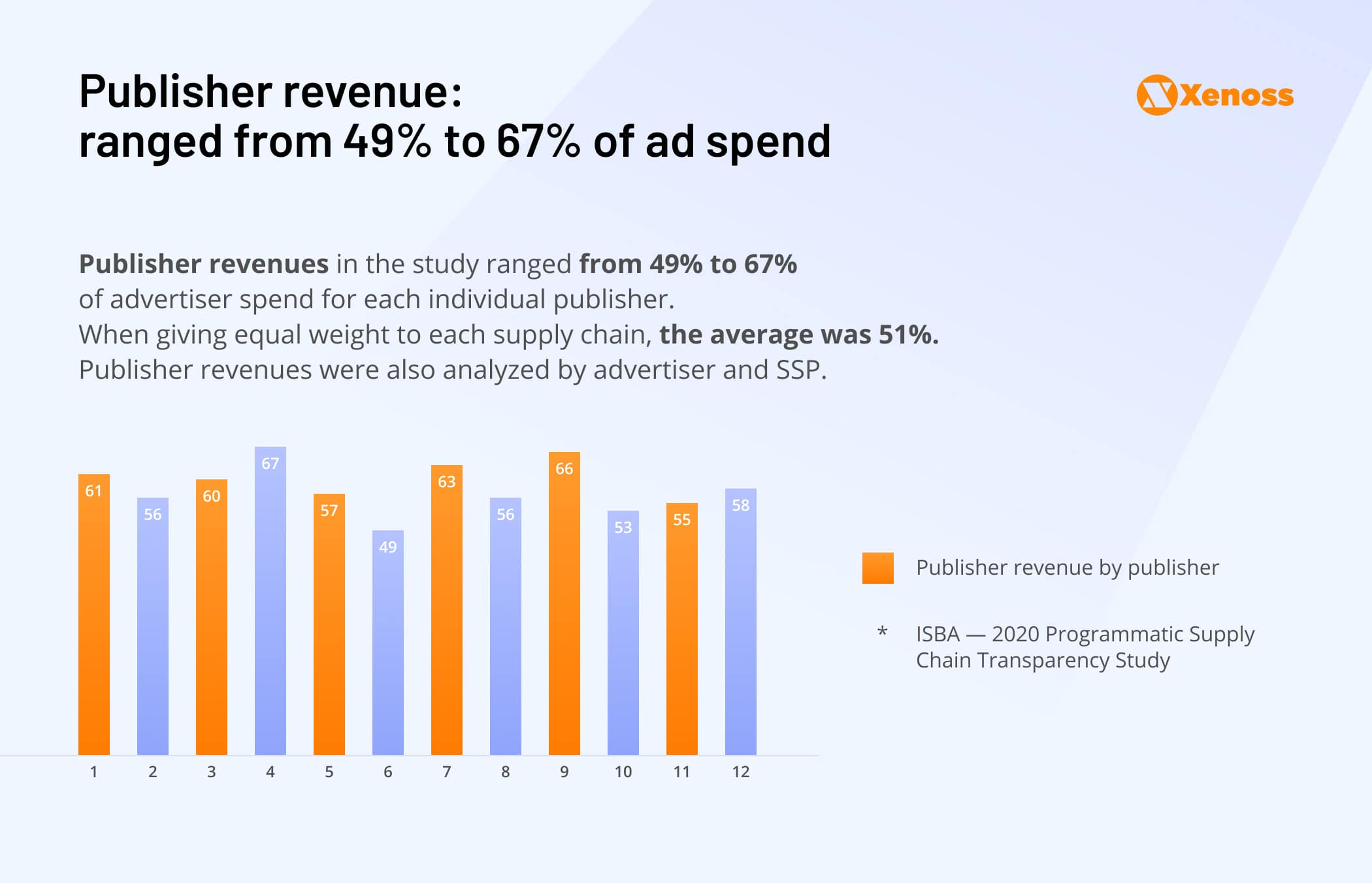
Where does the rest go?
Agency fees, DSP fees (+ tech fees), and SSP fees (+ tech fees) eat up a good chunk of possible profits. But also a staggering 15% of spending couldn’t be properly attributed to any party.
What does this data mean for AdTech platforms, gearing up for in-game advertising? Several things:
- Attracting and retaining high-profile game developers will be a problem if their payouts are consistently low.
- User retention will inevitably drop as more brands seek direct ad deals with select publishers to reduce in-game advertising costs.
In other words – you may be out of business if you cannot provide a transparent and competitive fee structure.
But the trouble is that many AdTech operators also struggle with cost attribution as their technical ecosystem grows larger than life.
6 technical solutions for overcoming in-game advertising challenges
Now that you know what you are up against, let’s take a look at how you can address these issues. You want to delight all ecosystem participants with a stellar in-game advertising experience. Here’s what it takes to develop it.
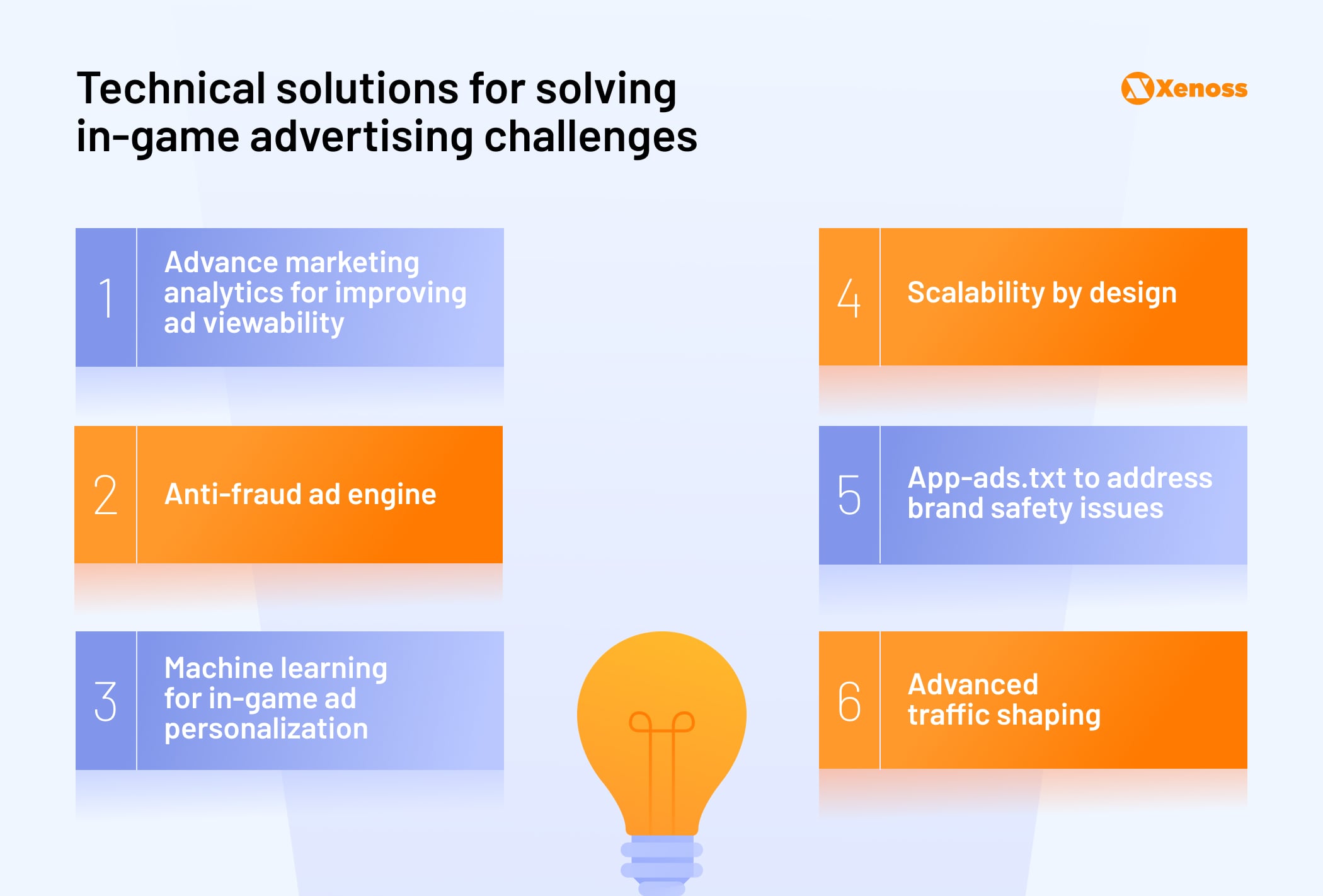
1. Implement advanced marketing analytics to improve ad viewability
At the beginning of the 20th century, the American department-store magnate, John Wanamaker, said:
“Half the money I spend on advertising is wasted; the trouble is I don’t know which half.”
In the 21st century, media buyers still get a similar feeling when their AdTech platform doesn’t provide sufficient analytics.
Ad viewability, in particular, is a metric that gets muddled more often than not as dishonest publishers try to maximize their display space by all means possible.
So how do you prevent ad viewability issues from creeping into in-game advertising?
For starters, implement IAB Open Measurement SDK – a tool for establishing viewability and verification measurements for ads served to mobile apps and web videos. This should get your bases covered.
Then look into designing a more advanced marketing data analytics ecosystem, one capable of providing users with:
- Accurate online conversion reports
- Custom metrics analysis and reporting
- Traffic analytics and filtering capabilities
- Publisher placements analysis
- Disrupted conversion efforts
- And more!
The main challenge, however, would be measuring ad viewability in 3D game environments since this option isn’t well-supported by off-the-shelf solutions.
One possible route is to build a custom machine learning-powered algorithm for scanning in-game ad placements. For example, you can train the algorithms to determine if other in-game objects are blocking ad display. Similarly, be sure to check how different in-game lighting conditions and camera positions affect ad viewability.
This granted patent further showcases how such a setup can function:
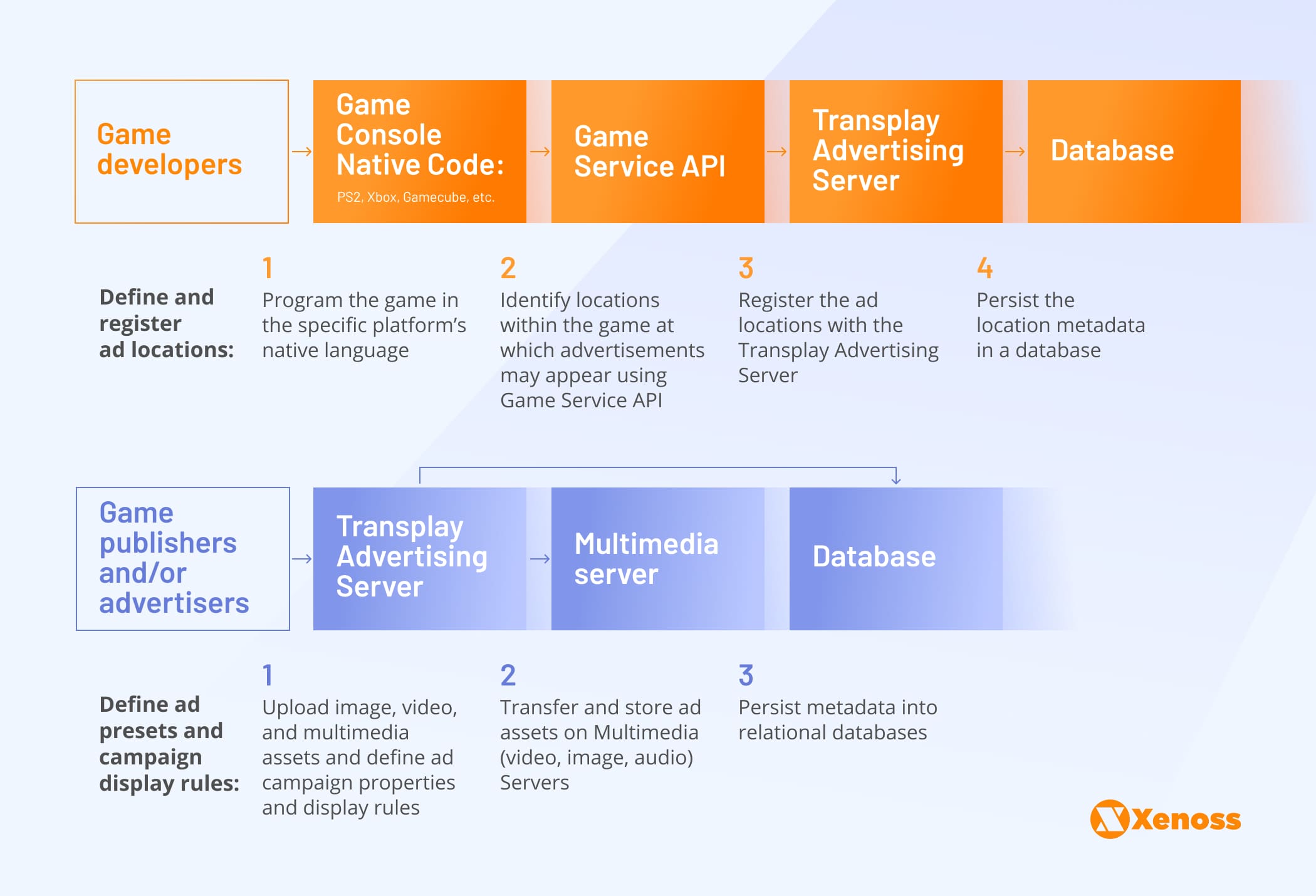
AdTech platforms that already use similar tools are driving attractive results for publishers. During one test campaign, the platform ensured that in 80.2% of cases game players saw 95% of ads for at least two seconds. For comparison, when the brand served banner ads through traditional display channels, ad viewability hovered at 65%.
So if you too would like to impress users with above-average ad viewability rates, custom analytics solutions are well worth considering.
2. Introduce an anti-fraud ad engine
A robust mobile ad fraud detection mechanism is a must for any AdTech working with mobile game publishers. Not having such a system is like leaving your garage door open and then wondering how your lawn mower was stolen.
Though ad fraud prevails in mobile games, other channels should be covered too. Namely:
- In-browser web games
- Console games
- Multiplayer online games
As CNBC reports, the amount of cyber fraud has jumped by 393% in the gaming industry as more people spent time playing during the pandemic. So you gotta stay protected at all ends.
The common exploits for both mobile and web games include malware distribution, account takeovers, unauthorized purchases, and the prevalence of bots – tampering with in-game mechanics and displayed ads.
To protect your platform from fraudulent crawlers, develop an anti-fraud system with two components:
- Monitoring unit – a platform-wide data processing and analytics system for monitoring performance across inventory.
- Fraud detection unit – a traffic filtering system and a platform-wide crawler for identifying and blocking suspicious behaviors.
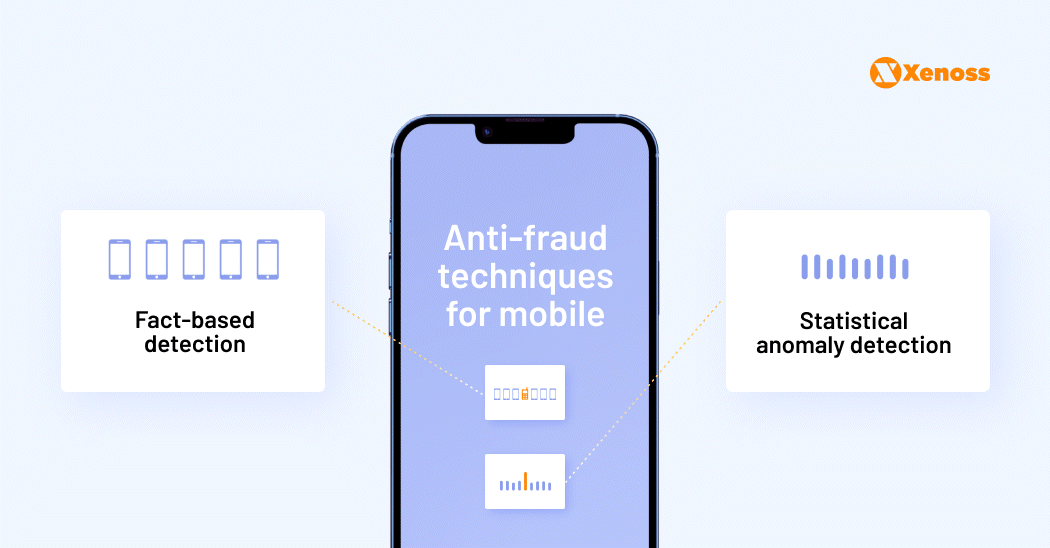
Let’s focus on the latter – in-game advertising fraud detection.
The two popular anti-fraud techniques for mobile are:
- Fact-based detection – the system relies on a list of characteristics and databases to establish fraudulent activity. For example, if we know that incoming traffic originates from an IP address associated with a cloud service, plus has an outdated browser version associated with it, we’ll block it from entering the system.
- Statistical anomaly detection – this method relies on capturing different in-game user behaviors and building correlations between legit and fake engagement. This method prevents publishers from generating bogus in-app engagement to attract advertisers.
For example, during a recent project, we helped a DSP implement a statistical fraud detection mechanism for their platform. The analytics-driven mechanism allows the platform to weed out dubious publishers who inflate user base numbers – daily active users, the average number of ad impressions, average conversion rates, etc. – using bots. As a result, their profitability rapidly increased and so did user satisfaction rates.
3. Consider machine learning for in-game ad personalization
Thanks to incredible progress in AI technologies, machine learning (ML), and deep learning (DL), AdTech platforms can implement an array of advanced in-game personalization tools.
Ultimately, your choice of personalization techniques is tied to your ability to collect and analyze data from publishers and translate it into brand-facing user analytics reports.
Understandably, that’s no easy task. Behavioral analytics is complex. Moreover, many smaller game publishers don’t have sufficient internal user analytics. Consequently, you may also want to create an SDK for them to help collect the required insights.
On the other hand, if you already have a good dataset on user behavior (or several), you can launch an MVP platform with robust functionality in 4 months. That was the case with one of our clients, Dataseat.
Using the supplied third-party data on user behaviors, we developed a DSP (media buying system) that could target users with a proven interest in specific game genres. Wondering how we achieve such development speed? By leveraging ready-to-use AdTech components, which are part of the Xenoss MarTech low-code platform.
4. Ensure scalability by design
AdTech software development has a unique degree of technical complexity.
That’s why high-load tolerance and scalability should be a by-design decision. But from our experience as a MarTech technology partner, people tend to grossly underestimate just how big the loads would be.
A large AdTech platform can rack up an annual AWS/Azure bill of $6-$10 million. So new players think that high AdTech infrastructure costs are the “norm.”
Guess what? They are not.
Vova Kyrychenko, CTO at Xenoss
Such thinking is prevalent because there are no publicly available benchmarks to use to verify if your cloud bill is all right or a tad too much. Due to that, many AdTech platform add-ons end up being a pricey expense, rather than a competitive advantage.
In such cases, partnering with an experienced AdTech development company gives you an unbeatable advantage – you get an accurate cost snapshot in advance.
Your partner can also help you right-size your technical architecture from the beginning so that you can end up with a more reasonable operational bill.
For instance, when Venatus, a leading global AdTech platform that focuses on gaming and entertainment, approached us with a Proof of Concept (POC) solution, the proposed architecture already had several inherent scalability and system performance issues. If those were unaddressed, their IT infrastructure bill would have gotten crazy high.
Our team performed an in-depth assessment of their cloud infrastructure and selected a tech stack. Based on the findings, we suggested several critical improvements, which our engineers delivered. This led to a 10X increase in system performance with a mild increase in TCO. You can read up on the full project details in our case study.
5. Implement app-ads.txt to address brand safety issues
To keep brands assured that only the best publishers are selling ad space on your platform, implement app-ads.txt.
Gaming app publishers can make a list of authorized AdTech platforms that can sell their ad inventory and codify this information on their website or in the app store listing. Then buyers (advertisers or DSPs) can use a crawler to verify if any SSP or ad exchange is authorized to sell the app developer’s inventory.
Essentially, this piece of code improves traceability and prevents common fraud scenarios such as domain spoofing and illegitimate inventory arbitrage. These two issues often affect brand safety.
Next, work on establishing different brand safety and suitability profiles for different types of advertisers. Such profiles may include:
- List of blacklisted content themes, locations, or specific IP addresses
- Whitelist of approved ad networks and independent game developers
- Maximum number of other ads, presented in the game
- Accepted range of devices, browser versions
- Minimal ad viewability requirements
- Preferred geo locations and demographics
Empowering brands with such analytics and reporting functionality can diminish most concerns around brand safety.
6. Add advanced traffic shaping (selective call out) functionality
As we mentioned, the AdTech supply chain lacks transparency, mostly because DSPs and SSPs don’t “communicate” well enough. That means important information (and money) gets lost in transition.
Traffic shaping is a proven mechanism for improving relationship governance within the AdTech ecosystem.
Traffic shaping is also called selective call-out – a term popularized by the Google team.
But the assumptions stay the same: such systems are meant to ensure harmonized AdTech platform performance.
From a tech perspective, this mechanism is important because:
- AdTech platforms are already facing huge loads. Too many (non-relevant) real-time bid requests put an extra strain on the ad network infrastructure.
- Owing to that, a network can participate in a limited number of auctions.
- Adding selective call-out functionality means that a network will get solicited only when the most relevant impressions are available.
Being selective pays off. Traffic shaping can drive a reduction of bid requests by 30-60%, while still maintaining nearly 100% of existing revenue for SSPs and their publisher partners.
At the same time, you get an added benefit of lower infrastructure TCO since you are not paying to process irrelevant traffic. Double sweet!
Here’s an example from Rivr AI on how their traffic shaping system works:
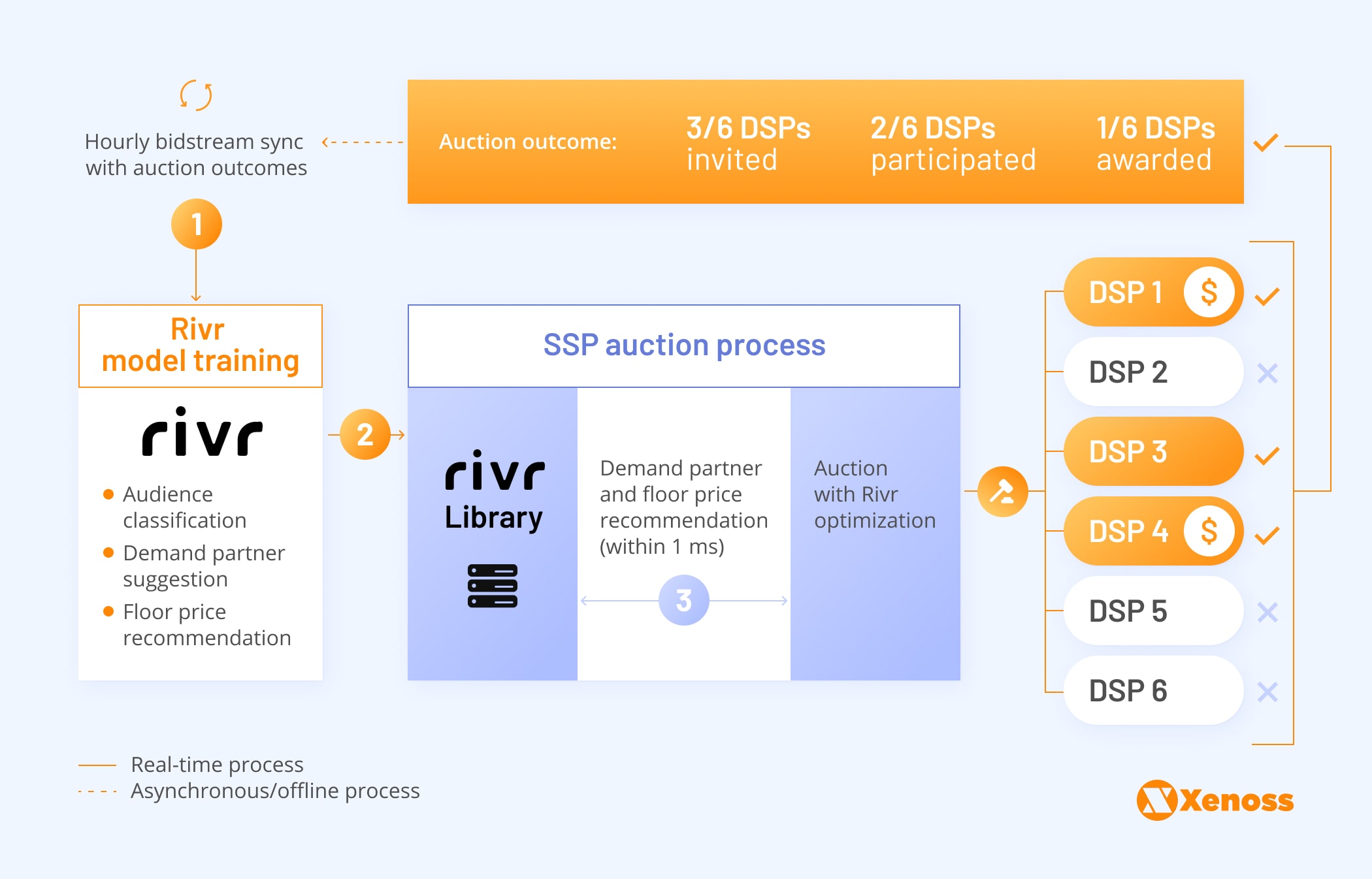
Conclusion
In-game advertising is a promising new pocket of growth for AdTechs. But dipping into it requires concrete preparation. If one element is amiss – be it platform infrastructure design, anti-fraud protection, or marketing analytics – you’ll have a hard time being profitable.
So if you are looking to launch a new solution, it’s good to have an experienced AdTech engineering team to warn you against the pitfalls and prime you for ongoing success.
